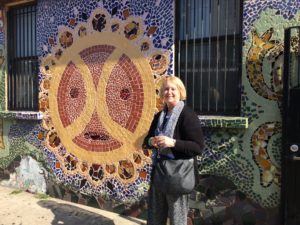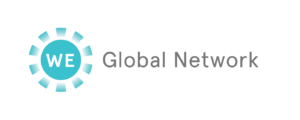2016 Convening Perspective: Q&A with Member Betsy Cohen, St. Louis Mosaic Project
Last week, Welcoming Economies Global Network (WE Global) brought together some 300 leaders in immigrant economic development for our 2016 Convening in Philadelphia. The convening included workshops to highlight cutting edge policies, successful programs, and innovative ideas that welcome, retain, and empower immigrants as valued contributors to our economies. We caught up with WE Global member Betsy Cohen, executive director of St. Louis Mosaic Project, to get her take on the Convening, and how the network supports her local work in St. Louis.

Betsy Cohen of St. Louis Mosaic Project in front of mosaics at Latino arts and services center in Philly.
Q: Tell us about St. Louis Mosaic Project.
Betsy: The St. Louis Mosaic Project started in 2013 based on two research studies showing that the region needs to attract foreign-born individuals to grow its population and for economic and cultural benefits. Our mission is for the St. Louis region to be the fastest growing major metro for foreign-born by 2020, and just last month, American Community Survey 2015 data of the top 20 major metros ranked the St. Louis metro the fastest growing region for foreign-born – so we’re on the right track!
Mosaic is a regional public-private partnerships within the St. Louis Economic Development Partnership and the World Trade Center St. Louis. The Mosaic Steering Committee, comprised of community leaders in business, government, agencies, faith, and social services, has been key to this progress. In addition, the International Institute’s work resettling refugees and the energy of more than 100 other community partners has been instrumental in reaching our goal in 2020.
Q: What brought you to your first WE Global Network Convening?
Betsy: I went to Detroit in 2013 for the inaugural Convening to learn from Steve Tobocman and about the immigrant economic development work being led by Global Detroit and its partners. As this was then, and still is, an emerging field, I wanted to find a peer group with whom to build trust and knowledge, which I did. Through WE Global Network and Welcoming America, I can both share our learnings as well as send a quick note to my peers for guidance on various elements of our local efforts in St. Louis. No need to reinvent the wheel when we have shared experiences to learn from and build upon, resulting in more effective (and faster) outcomes.
Q: What was the most inspiring moment of the 2016 Convening?
Betsy: I liked hearing Mayor Jim Kenney’s take on what this movement means to Philadelphia, and how it correlated to what I saw during the neighborhood tours and visiting the Reading Terminal Market the day before. Hearing from a regional leader that this work is important to the region and then seeing firsthand how this translates on the ground locally in neighborhoods shows how important it is to work at all levels of the ecosystem. It inspired me to return to St. Louis to do more for our community by engaging leaders as well as working at the grassroots level.
Q: What strategies are you taking home to explore using in St. Louis?
Betsy: We saw some uses of the arts to connect U.S.-born and foreign-born residents that were unique and effective. Also, the new homeownership report and tool highlighting the role of immigrants in helping revitalize urban neighborhoods will support us in starting conversations in St. Louis with data and motivation. The numbers are impressive.
Q: As a WE Global member, what value have you received since joining the Network?
Participating in the Network helps us to see how we compare to other regions on issues like housing, refugee integration, or international student hiring, and identify areas for growth or change. Through relationships built within the Network, and gatherings like the Convening, we learn effective strategies and concrete examples of their effectiveness, which we can bring home and share with local stakeholders. Other member regions have similar challenges, and opportunities, to St. Louis’, so the strategies are more translatable than those coming our of traditional gateway cities or markets with high populations of foreign-born residents.
Q: How do you feel this movement and the climate for this work has changed over last 5 years?
Betsy: As more communities join the welcoming banner, it adds strength to the approach even as national political discourse or our own state political discussions shift. It keeps us on a steady course for progress, and was not as certain five years ago. The momentum of the movement, which has grown immensely since 2010, strengthens our motivation and conviction to change minds, hearts, and legislation. Looking to 2017, I believe there will be clarity at the national level on the incorporation of welcoming activities into local inclusion work, and that will propel us forward even further. I’m sure all of us in different communities feel discouraged sometimes over negativity, but working together, sharing winning strategies, and being a part of the movement gives me hope for the future.
Q: How does your community create a welcoming community?
Betsy: The immense level of support and funding from the public-private partnership gave a significant push to the launch of our flagship programs that create a welcoming community: Mosaic Ambassadors are individuals, schools, and companies committed to welcoming and creating a culture of inclusion; Professional Connectors make networking introductions for foreign-born job seekers; Immigrant Entrepreneur programs support local innovators and job creation; and International Student and Corporate Hiring community resources empower the future workforce. The International Institute of St. Louis recently moved to a larger facility with a true walk-in Welcoming Center location where all foreign-born residents can receive the support they need.



